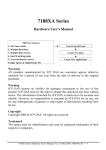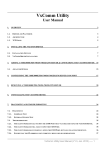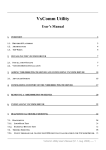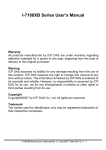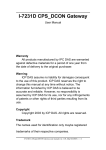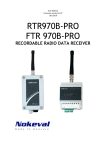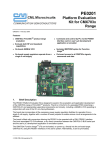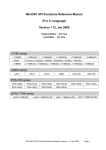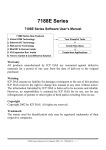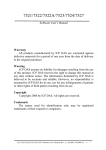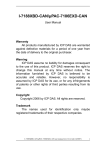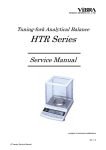Download 7188XB - ELVAC a.s.
Transcript
7188XB Series Hardware User’s Manual 7000 New Features 1. Self Tuner Inside Your Powerful Tools 2. Multiple Baud Rate 3. Multiple Data Format Create New Ideas 4. Dual WatchDog Inside 5. True Distributed Control Create New Applications 6. High Speed & High Density I/O Warranty All products manufactured by ICP DAS are warranted against defective materials for a period of one year from the date of delivery to the original purchaser. Warning ICP DAS assume no liability for damages consequent to the use of this product. ICP DAS reserves the right to change this manual at any time without notice. The information furnished by ICP DAS is believed to be accurate and reliable. However, no responsibility is assumed by ICP DAS for its use, nor for any infringements of patents or other rights of third parties resulting from its use. Copyright Copyright 2000 by ICP DAS. All rights are reserved. Trademark The names used for identification only may be registered trademarks of their respective companies. 7188XB Series Hardware User’s Manual, Ver. 3.0 May/2005, 7Mh-001-20 -----1 Table of Contents 1. 2. 3. INTRODUCTION ............................................................................................................................................................ 3 1.1 FEATURES .................................................................................................................................................................. 7 1.2 PIN ASSIGNMENT ..................................................................................................................................................... 11 1.3 SPECIFICATIONS ....................................................................................................................................................... 13 1.4 BLOCK DIAGRAM ..................................................................................................................................................... 15 1.5 WIRING DIAGRAMS FOR APPLICATION..................................................................................................................... 16 1.6 COMPARISON TABLE ................................................................................................................................................ 21 OPERATION PRINCIPLES ......................................................................................................................................... 24 2.1 SYSTEM MAPPING .................................................................................................................................................... 24 2.2 HOW TO DEBUG USER’S PROGRAMS ........................................................................................................................ 26 2.3 HOW TO DOWNLOAD USER’S PROGRAM .................................................................................................................. 27 2.4 USING THE DOWNLOAD_PORT AS A COM PORT ....................................................................................................... 27 2.5 COM PORTS COMPARISON....................................................................................................................................... 28 2.6 THE RS-485 PORT & SELF-TUNER ASIC................................................................................................................. 29 2.7 USING RED LED & 7-SEG LED DISPLAY............................................................................................................... 30 2.8 USING RTC & NVSRAM........................................................................................................................................ 30 2.9 USING EEPROM ..................................................................................................................................................... 31 2.10 USING THE WATCHDOG TIMER ................................................................................................................................ 31 2.11 USING THE I/O EXPANSION BUS .............................................................................................................................. 32 APPLICATIONS ............................................................................................................................................................ 41 3.1 EMBEDDED CONTROLLERS ...................................................................................................................................... 41 3.2 LOCAL REAL TIME CONTROLLER............................................................................................................................. 42 3.3 REMOTE LOCAL CONTROLLER ................................................................................................................................. 43 3.4 I/O EXPANSION OF PLC APPLICATIONS ................................................................................................................... 44 3.5 RADIO MODEM APPLICATIONS ................................................................................................................................ 45 3.6 USING 4 COM PORT APPLICATION-1 ....................................................................................................................... 46 3.7 USING 4 COM PORT APPLICATION-2 ....................................................................................................................... 47 7188XB Series Hardware User’s Manual, Ver. 2.0 May/2005, 7Mh-001-20 -----2 1. Introduction The 7188XB series is a series of expandable embedded controllers designed for industry applications. They can be used to replace the PC or PLC in harsh environments. The 7188X series can be ordered as following: Order Items Module name O. S. 7188XA(D) Expandable Embedded controller MiniOS7 7188XB(D) Expandable Embedded controller MiniOS7 7188XC(D) Expandable Embedded controller MiniOS7 7XXX 7XXX without 7-SEG display MiniOS7 7XXXD 7XXX with 7-SEG display MiniOS7 The 7000 series modules have been very successful during the past three years. Over one hundred thousand modules have been shipped to locations all over the world. The reasons for our success are given as follows: Time-to-market & cost-effective solutions Durable, stable, flexible, & easy to program Over 50 various I/O modules are supported Can be used in harsh, noisy industry environments However, even though the 7000 family is so versatile, there are some applications that cannot be initially solved, such as: High speed applications Special hardware requirement applications Special software requirement applications A combinations of special hardware & software applications 7188XB Series Hardware User’s Manual, Ver. 3.0 May/2005, 7Mh-001-20 -----3 Therefore, we developed an I/O expansion bus for the 7188X family to solve all the above applications above. The I/O expansion bus can be used to implement various I/O functions such as D/I, D/O, A/D, D/A, Timer/Counter, UART, flash memory, battery backup SRAM, AsicKey & other I/O functions. Nearly all kinds of I/O functions can be implemented by this bus. The I/O expansion bus includes serial & parallel interface. The parallel interface is very similar to ISA bus, so the user can move the old ISA bus design to the I/O expansion bus with very little modification. Furthermore, the I/O pins of the serial bus are programmable. They can be programmed as D/I, or D/O. Some pins can be configured to D/I or D/O or timer input or timer output. There are many serial interface devices today. The features of these serial devices are given as follows: Smaller size compared to parallel devices Lower cost compared to parallel devices Easier to design for isolation applications The serial interface of the I/O expansion bus can link to these serial devices very easily. The design of the I/O Expansion Bus makes the idea of a “Customized 7000 Module” come true. The features of a “Customized 7000 Module” are given as follows: 7188X+X?? Single module solution a “Customized 7000 Module” 7000 compatible command sets & RS-485 networking Easy hardware/software interface for user to design & manufacture their own special hardware & software Time-to-market ODM solution for user’s special requirements (any high speed, complex or combined functions of D/I/O, A/D, D/A,.., etc.) Durable, stable, flexible, time-to-market & cost-effective total solution. Some “Customized 7000 Modules” are available as follows: IKIT-09: LONG TIME DATA LOGGER=7188XBD+X800 IKIT-10: LONG TIME 7000 LOGGE=7188XBD+X600 7188XB Series Hardware User’s Manual, Ver. 2.0 May/2005, 7Mh-001-20 -----4 IKIT-11: ANALOG SIGNAL CONTROLLER=7188XBD+X801 More “Customized 7000 Modules” will be ready in the near future The 7188XB(D) has 14 user-defined pins. But the 7188X(B) don’t support the reconfiguration-resistor. So the user-defined pins of the 7188X family are given as follows: User defined pins 7188XA(D) 0 7188XB(D) 14 7188XC(D) 3 Reconfiguration pins 0 0 5 Customized I/O pins 0+0=0 14+0=14 3+5=8 Refer to “I/O Expansion Bus in 7188X/7188E User’s Manual” for more information. Refer to “7000 Bus Converter User Manual" chapter 1 for more information as follows: 1.1 1.2 1.3 1.4 1.5 7000 Overview 7000 Related Documentation 7000 Common Features 7000 System Network Configuration 7000 Dimensions Package List In addition to this manual, the package includes the following items: One 7188XB series hardware module One hardware manual (this manual) One release note One software utility disk or CD One download cable CA0910 for 7188XB Note If any of these items are missing or damaged, contact the local distributors for more information. Save the shipping materials and cartons in case you want to 7188XB Series Hardware User’s Manual, Ver. 3.0 May/2005, 7Mh-001-20 -----5 ship in the future. Release Note It is recommended to read the release note first. All important information will be given in release note as follows: • Where the “7188X/7521 Software User’s Manual” is • Where the “I/O Expansion Bus for 7188X/7188E User’s Manual” is • Where the software driver & diagnostic programs are 7188XB Series Hardware User’s Manual, Ver. 2.0 May/2005, 7Mh-001-20 -----6 1.1 Features 1.1.1 General features AMD’s embedded CPU, Am188™ES: 40M SRAM: 256K bytes Flash ROM: 512K bytes Built-in EEPROM Built-in RTC&NVRam Built-in COM port: COM1, COM2 64-bit hardware unique serial number inside User defined D/I/O Built-in 5-digit LED display interface COM driver support interrupt & 1K QUEUE input buffer Built-in I/O expansion bus interface Built-in watchdog timer for harsh environments Built-in power protection circuit Built-in RS-485 network protection circuit Built-in self-tuner ASIC controller on RS-485 port Program download from PC Built-in OS: MiniOS7 of ICP DAS Operating temperature: -25°C to +75°C Can be used in harsh environments for industry applications NOTE: 1. ODM wanted 2. “Customized 7000 Modules” wanted 7188XB Series Hardware User’s Manual, Ver. 3.0 May/2005, 7Mh-001-20 -----7 1.1.2 What is MiniOS7? The MiniOS7 is an embedded O.S. designed for the 7188X/7521 series. Developed by ICP DAS Co. Ltd; It is used to replace the ROMDOS used in the 7188 series. Several brands of DOS have been created by various companies. In all cases, DOS--whether PC-DOS, MS-DOS, or ROM-DOS--is a set of commands or code which tells the computer how to process information. DOS runs programs, manages files, controls information processing, directs input and output, and performs many other related functions. The MiniOS7 provides the equivalent functions of ROMDOS while, in addition, providing user specific functions for the 7188X/7521 family. Comparison table between MiniOS7 & ROM-DOS? MiniOS7 ROMDOS Power up time 0.1 sec 4 ~ 5 sec More compact size <64K bytes 64K bytes Supports I/O expansion bus Yes No Supports AsicKey Yes No Flash ROM management Yes No O.S. update (download) Yes No Built-in hardware diagnostic functions Yes No Direct control of the 7000 series modules Yes No Customer ODM functions Yes No Free charge Yes No Note: We reserve the right to change the specifications of MiniOs7 without notice 7188XB Series Hardware User’s Manual, Ver. 2.0 May/2005, 7Mh-001-20 -----8 1.1.3 What is the 64-bit hardware unique serial number? The 7188XB equips a 64-bit hardware unique hardware serial number onboard. This number is unique & cannot be shared by any two 7188XBs. The application software can check this number for illegal copies. It is the most low cost protection mechanism the 7188XB family currently has 1.1.4 What is the Self-Tuner ASIC? The 2-wire RS-485 port is designed to directly drive the 7000 series modules. It is a half-duplex 2-wire RS-485 network. Send/receive directional control in a 2-wire RS-485 network is very important. Therefore, the 7188X/7521 series equip a Self-Tuner ASIC controller for all RS-485 ports. The Self-Tuner ASIC controller will auto detect & control the send/receive direction of the RS-485 network. Consequently, the application program does not have to worry about the send/receive directional control of the RS-485 network. 1.1.5 What is the I/O Expansion Bus? The 7188XB support I/O expansion buses. The I/O expansion bus can be used to implement various I/O functions such as D/I, D/O, A/D, D/A, Timer/Counter, UART, flash memory, battery backup SRAM, AsicKey & other I/O functions. Nearly all kinds of I/O functions can be implemented on this bus. 1.1.6 What is the AsicKey? The I/O expansion bus supports AsicKey. The AsicKey equips a complex machine for validation checking. Included in this is 128 bytes of private data for the same purpose. It provides very strong protection against illegal copies. Every legal user has a unique AsicKey & unique software library, the user can self check this key, or the software library will check the key automatically. In this main, it is nearly impossible to remove the AsicKey protection. 7188XB Series Hardware User’s Manual, Ver. 3.0 May/2005, 7Mh-001-20 -----9 1.1.7 7188XB = Addressable RS-232 Converter? The 7188XB is designed as an embedded controller. Therefore, any software can be downloaded into it. If the firmware for an ”Addressable RS232 Converter” is downloaded into a 7188XB, they will act as an “Addressable RS-232 Converter”. 7188XB Series Hardware User’s Manual, Ver. 2.0 May/2005, 7Mh-001-20 -----10 1.2 Pin Assignment i-7188XB Embedded Controller CPU 80188-40 COM1 : RS-232 / RS-485 COM2 : RS-485 15~28 : User Define I/O Pin DI:3.5V~30V DO:100mA,30V max COM 1 COM2 7188XB Series Hardware User’s Manual, Ver. 3.0 May/2005, 7Mh-001-20 -----11 Pin assignment of bottom 14-pin screw terminal block(7188XB/7188XBD): Pin Name Description 1 DO 100 mA, 30V max. 2 DI 3.5V ~ 30V 3 D1+ DATA+ pin of COM1 (RS-485) 4 D1DATA- pin of COM1 (RS-485) 5 CTS1 Clear To Send of COM1 (RS-232) 6 RTS1 Request To Send of COM1 (RS-232) 7 GND Signal ground of RS-232 8 TXD1 Transmits Data of COM1 (RS-232) 9 RXD1 Receives Data of COM1 (RS-232) 10 INIT* Initial pin, 3.5V ~ 30V 11 D2+ DATA+ pin of COM2 (RS-485) 12 D2DATA- pin of COM2 (RS-485) 13 +VS V+ of power supply (+10 to +30VDC unregulated) 14 GND GND of power supply Note: The COM1 can be used as a RS-232 port or a RS-485 port. It is not recommended to use both RS-232 & RS-485 at the same time. Pin assignment of top 13-pin screw terminal block(7188XB/7188XBD): 15 Pin 15 User defined pin 15 16 Pin 16 User defined pin 16 17 Pin 17 User defined pin 17 18 Pin 18 User defined pin 18 19 Pin 19 User defined pin 19 20 Pin 20 User defined pin 20 21 Pin 21 User defined pin 21 22 Pin 22 User defined pin 22 23 Pin 23 User defined pin 23 24 Pin 24 User defined pin 24 25 Pin 25 User defined pin 25 26 Pin 26 User defined pin 26 27 Pin 27 User defined pin 27 28 Pin 28 User defined pin 28 7188XB Series Hardware User’s Manual, Ver. 2.0 May/2005, 7Mh-001-20 -----12 1.3 Specifications General environment Operating temperature: -25°C to +75°C Storage temperature:-40°C to +85°C Humidity: 0 to 90 % Built-in Watch Dog Timer (1.6 seconds) Built-in power protection & network protection circuit Program downloadable from PC Built-in I/O expansion bus interface 1.3.1 Specifications of 7188XB & 7188XBD System Module name: embedded controller CPU: Am188™ES, 40M Hz SRAM: 256K bytes FLASH ROM: 512K bytes COM port: COM1, COM2 Built-in RTC, NVRAM, EEPROM, D/I, D/O User defined pins:14, pin-15 ~ pin-28 Supports I/O Expansion Bus Program download port: COM1 Real Time Clock Year-2000 compliance Seconds, minutes, hours, date of the month Month, year, valid from 1980 to 2079 NVSRAM: 31 bytes, battery backup, data valid up to 10 years EEPROM 2048 bytes ( 8 blocks, each block has 256 bytes) Data retention > 100 years 1,000,000 erase/write cycles Flash Memory 512K bytes Erase unit is one sector(64K bytes) 7188XB Series Hardware User’s Manual, Ver. 3.0 May/2005, 7Mh-001-20 -----13 100,000 erase/write cycles D/I: 1 channel High:3.5V ~ 30V, Low:0 ~ 1V D/O: 1 channel 100 mA, 30V max. COM1 RS-232 or RS-485 RS-232: TXD,RXD,RTS,CTS,GND RS-485: D1+, D1-, self-tuner ASIC inside Communication speed: 115200 max. COM2 RS-485: D2+, D2-, self-tuner ASIC inside Communication speed: 115200 max. Display 7-segmemt LED: 5-digit (for 7188XBD) Power Power requirements: 10 to 30VDC(non-regulated) Power consumption: 2.0W for 7188XB 3.0W for 7188XBD For ODM User SRAM can be 512K max. COM2 can be 3000V isolated EEPROM can be 32K bytes 7188XB Series Hardware User’s Manual, Ver. 2.0 May/2005, 7Mh-001-20 -----14 1.4 Block Diagram SRAM=256K Flash-ROM=512K RTC & NVSRAM COM1 RS-232/RS-485 D/O=1 channel 150 mA, 30V D/I=1 channel 3.5V ~30V Watchdog circuit 80188-40 16 bits timer EEPROM (2K) 5-digit LED (options) COM2,RS-485 +5V 7188XB +10V to +30V power converter User defined pin=14 7188XB Series Hardware User’s Manual, Ver. 3.0 May/2005, 7Mh-001-20 -----15 1.5 Wiring Diagrams for Application 1.5.1 Program download 7188XB/7188XBD GND 15 28 14 Ext. GND +VS 13 Ext. 24V D2- 12 D2+ 11 INIT* 10 RXD1 9 RX TXD1 8 GND 7 TX GND RTS1 6 CTS1 5 D1- 4 D1+ 3 DI 2 DO 1 Connect INIT* to GND to disable autoexec.bat Wire label of CA0910 PC COM-1/2/3/4 RI 9 CTS 8 RTS 7 DSR 6 GND 5 DTR 4 TXD 3 RXD 2 DCD 1 Note: • There are 3 wires in the download cable • Connect the wire-1, label RX, to pin-8 of 7188XB • Connect the wire-2, label TX, to pin-7 of 7188XB Program download wire connection 7188XB Series Hardware User’s Manual, Ver. 2.0 May/2005, 7Mh-001-20 -----16 • Connect the wire-3, label GND, to pin-6 of 7188XB • Connect the DB-9 of download cable to PC COM-1/2 port 7188XB Series Hardware User’s Manual, Ver. 3.0 May/2005, 7Mh-001-20 -----17 1.5.2 Using a 3-wire RS-232 port 7188XB/7188XBD RXD TXD GND RS-232 Device RI CTS RTS DSR GND DTR TXD RXD DCD There are 3 wires as following: • Connect RXD to TXD of RS-232 device • Connect TXD to RXD of RS-232 device • Connect GND to GND of RS-232 device 7188XB Series Hardware User’s Manual, Ver. 2.0 May/2005, 7Mh-001-20 -----18 1.5.3 Using a 5-wire RS-232 port 7188XB/7188XBD RXD TXD GND RTS CTS RS-232 Device RI CTS RTS DSR GND DTR TXD RXD DCD There are 5 wires as follows: • Connect RXD to TXD of RS-232 device • Connect TXD to RXD of RS-232 device • Connect RTS to CTS of RS-232 device • Connect CTS to RTS of RS-232 device • Connect GND to GND of RS-232 device 7188XB Series Hardware User’s Manual, Ver. 3.0 May/2005, 7Mh-001-20 -----19 1.5.4 Using a RS-485 port 7188XB/7188XBD GND 7000 module 14 Ext. GND +VS 13 Ext. 24V D2- 12 D2+ 11 GND 10 Ext. GND +VS 9 Ext. 24V D2- 8 D2+ 7 Note: • The RS-485 interface can directly drive 256 sets of 7000 modules without a repeater 7188XB Series Hardware User’s Manual, Ver. 2.0 May/2005, 7Mh-001-20 -----20 1.6 Comparison Table Comparison table between the 7188 & the 7188X series: 7188(D) 7188XC(D) 7188XB(D) 7188XA(D) CPU clock 80188, 40M Hz 80188,20M Hz 80188, 40M Hz 80188, 40M Hz SRAM 256K 128K 256K 512K Flash ROM 256K/512K 256K (512K for ODM) 512K 512K COM1 RS-232 with modem control or RS-485 RS-232 or RS-485 with self-tuner inside RS-232 or RS-485 with self-tuner inside RS-232 with modem control or RS-485 with self-tuner inside COM2 RS-485, RS-485 with self-tuner inside RS-485 with self-tuner inside RS-485 with self-tuner inside, 3000V isolation COM3 RS-232 (txd,rxd) No Com3 No Com3 RS-232 (txd,rxd) COM4 RS-232 (txd,rxd) No Com4 No Com4 RS-232 (txd,rxd) User defined pins 0 3 14 0 Modem control COM1 No No COM1 RTC Yes No Yes Yes 64 bits hardware unique serial number No No Yes Yes EEPROM 2K bytes 2K bytes 2K bytes 2K bytes D/I(3.5V~30V) 0 3 channels 1 channel 2 channels D/O(150mA, 30V) 0 3 channels 1 channel 2 channels I/O expansion bus No Yes Yes Yes Support AsicKey No Yes Yes Yes Operation system MiniOS7 MiniOS7 MiniOS7 MiniOS7 Programming TC/MSC/BC TC/MSC/BC TC/MSC/BC TC/MSC/BC COM1 COM1 COM4 language Program download COM4 7188XB Series Hardware User’s Manual, Ver. 3.0 May/2005, 7Mh-001-20 -----21 Comparison table of 7188E series: 7188EA(D) 7188EX(D) 7188E2(D) CPU clock 80188, 40M Hz 80188, 40M Hz 80188, 40M Hz SRAM 512K 512K 256K Flash ROM 512K 512K 256K COM1 RS-232 or RS-232 or RS-232 or RS-485 with self-tuner inside RS-485 with self-tuner inside RS-485 with self-tuner inside RS-485 with RS-485 with RS-485 with self-tuner inside, self-tuner inside, self-tuner inside, non-isolated non-isolated non-isolated RTC Yes Yes No 64 bits hardware unique serial number Yes Yes No EEPROM 2K bytes 2K bytes 2K bytes D/I(3.5V~30V) 6 channels 0 0 D/O(150mA, 30V) 7 channels 0 0 User Defined pins 0 14 0 I/O expansion bus Yes (but used by system) Yes No Support AsicKey Yes Yes No Operation system MiniOS7 MiniOS7 MiniOS7 Programming language TC/MSC/BC TC/MSC/BC TC/MSC/BC Program download COM1 COM1 COM1 Ethernet interface 10BaseT 10Base-T 10BaseT COM2 7188XB Series Hardware User’s Manual, Ver. 2.0 May/2005, 7Mh-001-20 -----22 Comparison table of CPU modules: Description 7188 Embedded Controller 7188XA Expandable Embedded Controller with I/O Expansion Bus 7188XB Expandable Embedded Controller with I/O Expansion Bus, high I/O expansion 7188XC Expandable Embedded Controller with I/O Expansion Bus, low cost 7521/22/23 Embedded Communication Controller, 1/2/3 channels 7188EA Embedded Internet/Ethernet Controller, DI * 6 channels, DO * 7 channels 7188EX Embedded Internet/Ethernet Controller with I/O Expansion Bus 7188E1 Internet Communication Controller, RS232 * 1 7188E2 Internet Communication Controller, RS232 * 1 + RS485*1 7188E3 Internet Communication Controller, RS232 * 1 + RS485 * 1+RS422/485 * 1 + DI * 4 +DO * 4 7188E4 Internet Communication Controller, RS232 * 3 + RS485*1 7188E5 Internet Communication Controller, RS232 * 4 + RS485*1 7188E8 Internet Communication Controller, RS232 * 7 + RS485*1 7188XB Series Hardware User’s Manual, Ver. 3.0 May/2005, 7Mh-001-20 -----23 2. Operation Principles 2.1 System Mapping 2.1.1 Address Mapping of the 7188XB Device Flash ROM SRAM COM1 BASE COM2 BASE Interrupt No. 0 1 2 3 4 5 6 7 8 9 0A 0B 0C 0D 10 11 Address mapping 256K: from C000:0000 to F000: FFFF 512K: from 8000:0000 to F000: FFFF 128K: from 0000:0000 to 1000:FFFF 256K: from 0000:0000 to 3000:FFFF 0XFF80 to 0XFF88 0XFF10 to 0XFF18 Interrupt mapping Divided by zero Trace NMI Break point Detected overflow exception Array bounds exception Unused opcode exception ESC opcode exception Timer 0 Reserved DMA-0 DMA-1 \INT0 of I/O expansion bus \INT1 of I/O expansion bus XB: \INT4 of I/O expansion bus XC: Reserved COM2 7188XB Series Hardware User’s Manual, Ver. 2.0 May/2005, 7Mh-001-20 -----24 12 13 14 2.1.2 Timer 1 Timer 2 COM1 Address Mapping of the X505, X506, X507 DI DO BASE COM3 INT BASE COM4 INT BASE COM5 INT BASE COM6 INT BASE COM7 INT BASE COM8 INT X505 N/A N/A 0X10 INT0 0X18 INT1 0X20 INT4 N/A N/A N/A N/A N/A N/A X506 N/A N/A 0X10 INT0 0X18 INT0 0X20 INT1 0X28 INT1 0X30 INT4 0X38 INT4 X507 0 0 0X10 INT0 N/A N/A N/A N/A N/A N/A N/A N/A N/A N/A 7188XB Series Hardware User’s Manual, Ver. 3.0 May/2005, 7Mh-001-20 -----25 2.2 How to Debug User’s Programs The download_ports of the 7188XB are given as follows: • 7188XB Use COM1 When the 7188XB series is powered-up, it will initialize the download_port to the following configuration: • Start-bit=1, data-bit=8, stop-bit=1, no parity • Baud rate = 115200 BPS Then, the 7188XB will send all power-up information to the download_port. The user will see all power-up messages as follows: • Power-off PC & 7188XB • Install the download cable between download_port of 7188XB & COM1 of PC (refer to Sec. 1.6) • Power-up PC & Run 7188X.EXE • Power-up 7188XB • All power-up message will be shown on the monitor of the PC After the power-up stage, the 7188XB will use the download_port as its standard input/output. So the standard output of 7188XB will be shown on the PC’s monitor. If the user presses any key on the PC’s keyboard, this key will be sent to the 7188XB as standard input. Therefore the keyboard & monitor of PC can be used as standard input & output of the7188XB as follows: • Use 7188X.EXE as a bridge between the 7188XB & PC • Run 7188X.EXE in PC to set up this bridge • Keyboard of PC standard input of 7188XB • Monitor of PC standard output of 7188XB In this way, the 7188XB can read data from the keyboard & display it on the monitor. So program debugging will be more convenient & effective. Note: 7188X.EXE is included on the companion floppy disk/CD. 7188XB Series Hardware User’s Manual, Ver. 2.0 May/2005, 7Mh-001-20 -----26 2.3 How to Download User’s Program Refer to Sec. 2.2 to find the download_port first. The user can download the program into the 7188XB as follows: • Power-off PC & the 7188XB • Install the download cable between download_port of the 7188XB & COM1 of PC (refer to Sec. 1.6.1) • Power-up PC & Run 7188X.EXE • Power-up the 7188XB • All power-up messages will be shown on the monitor of the PC • Key-in “load”, press Enter key, & wait for system request message • Press Alt-E, the screen will ask you to input filename, • Key-in the filename & press Enter key, the file will be download into the 7188XB • Key-in the filename & press Enter. This will start to execute this file • Pressing Alt & X at the same time will quit the 7188X.EXE 2.4 Using the download_port as a COM port The user can use the download_port of the 7188XB series as a general purpose RS-232 port as follows: Download user’s program & autoexec.bat to the 7188XB first. Power off the 7188XB & remove the download the cable from PC. If they are connected, disconnect the INIT*-pin from GND-pin of the 7188XB Power on the 7188XB (no standard input, no standard output, no debug information) Install the download cable between new RS-232 device & download_port of the 7188XB Initialize the download_port to new configuration. The download_port is a general purpose RS-232 port now. Refer to “7188X Software User’s Manual” for demo programs 7188XB Series Hardware User’s Manual, Ver. 3.0 May/2005, 7Mh-001-20 -----27 2.5 COM ports Comparison The COM port of the 7188XB series can be RS-232 or RS-485 as follows: type Pins name 2-wire RS-485 Data+, Data3-wire RS-232 Txd,Rxd,Gnd 5-wire RS-232 Txd,Rxd,Gnd,Rts,Cts 9-wire RS_232 Txd,Rxd,Gnd,Rts,Cts,Dcd,Dtr,Dsr,Ri The COM ports of the 7188XB are given as follows: COM port Hardware COM1 80188’s on-chip UART-0, 5-wire RS-232 & 2-wire RS-485 COM2 80188’s on-chip UART-1, 2-wire RS-485 7188XB Series Hardware User’s Manual, Ver. 2.0 May/2005, 7Mh-001-20 -----28 2.6 The RS-485 Port & Self-Tuner ASIC The 2-wire RS-485 port is designed to directly drive 7000 series modules. It is a half-duplex 2-wire RS-485 network. Send/receive directional control in a 2-wire RS-485 network is very important. Therefore, the 7188X series equip a Self-Tuner ASIC controller for all RS-485 ports. The Self-Tuner ASIC controller will auto detect & control the send/receive direction of the RS-485 network. In this main, the application program does not have to worm about the send/receive direction control of the RS-485 network. For example, the software program for one-to-one communication is nearly the same. ToCom(port, sent_data); /* send one sent_char to RS-232/RS-485 */ */ /* no direction control while IsCom(port); /* wait one echo_char from RS-232/RS-485 */ echo_data=ReadCom(port); /* read this echo_data */ RS-232 TXD, RXD, GND 7188XB 7188XB RS-485 Data+, Data- 7188XB 7188XB Self-Tuner ASIC 2-wire RS-485 network Inside Send/receive direction Auto detect/control 7188XB Series Hardware User’s Manual, Ver. 3.0 May/2005, 7Mh-001-20 -----29 2.7 Using Red LED & 7-SEG LED Display The red LED of the 7188XB series can be turned-ON or turned-OFF by its software program. The 5 digits of the seven-segment LED are also programmable. The 5-digit LED is very useful in real world applications. It can be used to replace the monitor & touch-screen for many applications. 2.8 Using RTC & NVSRAM The RTC & NVSRAM are located on the same chip. There is a Li-battery to backup the RTC & NVSRAM for 10 years. The features of the RTC are given as follows: • MiniOS7 supports RTC time & date • Seconds, minutes, hours, date of the month • Month, day of week, year, Leap year valid up to 2079 NVSRAM: 31 bytes, data valid for 10 years Note1: only 7188XA & 7188XB support RTC & NVRAM. 7188XB Series Hardware User’s Manual, Ver. 2.0 May/2005, 7Mh-001-20 -----30 2.9 Using EEPROM The EEPROM is designed to store the data which is not changed very frequently. This data is given as follows: Module ID, configuration settings COM port configuration settings Small databases The erase/write cycle of the EEPROM is limited, the user should not change the EEPROM frequently for testing. The EEPROM can erase/write in single byte, so it is very useful in real world applications. 2.10 Using the Watchdog Timer The watchdog timer of the 7188XB series is fixed at 1.6 sec. When the 7188XB is powered up, the watchdog timer will be always enabled. If the 7188XB do not refresh the watchdog timer every 1.6 seconds, the watchdog will RESET the 7188XB. The MiniOS7 of the 7188XB will automatically refresh the watchdog after power up. The user program can call the software driver to tell MiniOS7 to stop refreshing the watchdog timer, then the user program must refresh the watchdog timer. If the user program does not refresh the watchdog timer every 1.6 seconds, the watchdog timer will RESET the 7188XB. 7188XB Series Hardware User’s Manual, Ver. 3.0 May/2005, 7Mh-001-20 -----31 2.11 Using the I/O Expansion Bus The 7000 series modules have been very successful in during the past three years. Over one hundred thousand modules have been shipped to locations all over the world. The reasons for our success is given as follows: Time-to-market & Cost effective solutions Durable, Stable, Flexible & Easy programming Over 50 Various I/O Modules are supported Can be used in harsh & noisy industry environments However, even though the 7000 family is so versatile, there are some applications that cannot be solved. These applications are given as follows: High speed applications Special hardware requirement applications Special software requirement applications A combination of special hardware & software applications Therefore, we developed an I/O expansion bus for the 7188X family to solve all the above applications. The I/O expansion bus can be used to implement various I/O functions such as D/I, D/O, A/D, D/A, Timer/Counter, UART, flash memory, battery backup SRAM, AsicKey & other I/O functions. Nearly all kinds of I/O functions can be implemented by this bus. The I/O expansion bus includes serial & parallel interface. The parallel interface is very similar to ISA bus, so the user can move the old ISA bus design to the I/O expansion bus with very little change. The I/O pins of serial bus are programmable. They can be programmed as D/I, or D/O. Some pins can be configured to D/I or D/O or timer input or timer output. There are many serial interface devices available today. The features of these serial devices are given as follows: Smaller size compared to parallel devices Lower cost compared to parallel devices Easier to design for isolated applications The serial interface of the I/O expansion bus make interface to these serial devices very easy. 7188XB Series Hardware User’s Manual, Ver. 2.0 May/2005, 7Mh-001-20 -----32 The combination of serial & parallel interface make the I/O expansion bus very convenient & powerful for various industry applications. There are many design examples given in “I/O Expansion Bus in the 7188X User’s Manual”. All hardware circuit & software driver sources are OPEN for modification. From these examples, the user can make new applications or modify them for their special requirements. The system design steps are given as follows: Step 1: list all functions required Step 2: for all functions, goto step 3. If all functions are solved STOP Step 3: if this function can be solved by 7000 module goto step 2 Step 4: if this function can be solved by 7188X+X??? goto step 2 Step 5: user designed special hardware for I/O expansion bus Step 6: user writes special software driver for this hardware Step 7: combine the special hardware & software as a new module Step 8: goto step 2 After the above steps, user can combine the standard 7000 modules & special modules to solve all applications in the same RS-485 network. The system is given as following: 7520 RS232 RS485 Host PC RS485 Standard 7000 module Standard 7000 module RS485 Customized 7000 module (7188X+X???) Customized 7000 module (7188X+X???) 7188XB Series Hardware User’s Manual, Ver. 3.0 May/2005, 7Mh-001-20 -----33 2.11.1 Definition of an I/O Expansion Bus The I/O expansion bus of the 7188XB series can be divided into 3 groups as follows: 1. Power supply & reset signals: VCC, GND, RESET, /RESET 2. Parallel Bus: • System clock: CLOCKA • Asynchronous ready control: ARDY • Address bus: A0 ~ A6, A7 • Data bus: D0 ~ D7 • Interrupt control: INT0, INT1, INT4 • Chip select & read/write strobe: /CS, /WR, /RD 3. Serial Bus: TO_0, TO_1, TI_0, TI_1, SCLK, DIO9, DIO4, DIO14 Refer to “I/O Expansion Bus for 7188X/7188E User’s Manual” for more information. 7188XB Series Hardware User’s Manual, Ver. 2.0 May/2005, 7Mh-001-20 -----34 2.11.2 Definition The definition of the I/O expansion bus is given as follows: JP1 pin definition & description: No Name Description 1 GND Ground of PCB 2 GND Ground of PCB 3 CLOCKA Synchronous clock output of CPU 4 ARDY Asynchronous ready input (level sensitive, OPEN=ready) 5 INT0 Interrupt request input of channel 0(asynchronous, active high) 6 INT1 Interrupt request input of channel 1(asynchronous, active high) 7 VCC Power supply of PCB 8 RESET Power up reset pulse (active high) 9 GND Ground of PCB 10 /RESET Power up reset pulse (active low) 11 TO_0 Timer output 0 of CPU (can be used as programmable D/I/O) 12 TO_1 Timer output 1 of CPU (can be used as programmable D/I/O) 13 TI_0 Timer input 0 of CPU (can be used as programmable D/I/O) 14 TI_1 Timer input 1 of CPU (can be used as programmable D/I/O) 15 SCLK Common serial clock output of 7188 series 16 DIO9 Programmable D/I/O bit 17 DIO4 Programmable D/I/O bit 18 DIO14 Programmable D/I/O bit 19 VCC Power supply of PCB 20 VCC Power supply of PCB • • • • • • CLOCKA: 40M for 7188XB ARDY: leave this pin OPEN for no wait states applications INT0, INT1: leave these two pins OPEN for no interrupt applications TO_0, TO_1: can be used as CPU’s timer output or programmable D/I/O TI_0, TI_1: can be used as CPU’s timer input or programmable D/I/O DIO4, DIO9, DIO14: programmable D/I/O bit • SCLK: the 7188X/7188E series use this signal as a CLOCK source to drive all on-board serial devices, so it is always programmed as D/O. Changing this signal to other configurations will cause serious errors. User can use this signal to drive external serial devices without any side effects. 7188XB Series Hardware User’s Manual, Ver. 3.0 May/2005, 7Mh-001-20 -----35 JP2 pin definition & description: No Name Description 1 A0 Address bus 2 D0 Data bus 3 A1 Address bus 4 D1 Data bus 5 A2 Address bus 6 D2 Data bus 7 A3 Address bus 8 D3 Data bus 9 A4 Address bus 10 D4 Data bus 11 A5 Address bus 12 D5 Data bus 13 A6 Address bus 14 D6 Data bus 15 A7 or N/C This pin is reserved & must be N/C for 7188XC & 7521 series 16 D7 Data bus 17 INT4 or N/C Interrupt request input of channel 4(asynchronous, active high), this pin is reserved & must be N/C for 7188XC & 7521 series 18 /WR Write strobe output (synchronous, active low) 19 /CS Chip select output (synchronous, active low) 20 /RD Read strobe output (synchronous, active low) • • • • • Address bus (output): A0 ~ A6, A7 Data Bus (tri-state, bi-direction): D0 to D7 INT4: leave this pin OPEN for no interrupt applications /CS, /RD, /WR: These 3 signals will be synchronous to CLOCKA (in JP1.3) & asynchronous to ARDY (JP1.4) The CS\ will be active if program inport/outport from I/O address 0 to 0xff. Refer to “I/O Expansion Bus in the 7188X/7188E User’s Manual” for more information. 7188XB Series Hardware User’s Manual, Ver. 2.0 May/2005, 7Mh-001-20 -----36 2.11.3 Parallel Bus Timing Diagram t1 t3 t2 t4 Data Phase Address Phase CLKOUTA A12-A0 Address /CS /RD D7-D0 (Read) Data /WR D7-D0 (Write) Data Case 1 tw tw tw t4 Case 2 t3 tw tw t4 Case 3 t2 t3 tw t4 Case 4 t1 t2 t3 t4 Address Phase Data Phase CLKOUTA ARDY (Normally Not-Ready System) ARDY (Normally Ready System) . 7188XB Series Hardware User’s Manual, Ver. 3.0 May/2005, 7Mh-001-20 -----37 2.11.4 I/O Expansion Boards I/O expansion board for prototype & testing: Board Descriptions X000 Prototype Board ( Small size) XA/XC X001 Prototype Board ( Large size) XA/XC X002 Prototype Board XA/XB/XC/EX X003 Self-test board for 7188XC XC X004 Self-test board for 7188XB/EX XB/EX X005 Prototype Board ( small size) XB/EX X006 Prototype Board ( Large size) XB/EX More…... I/O expansion board for D/I, D/O, D/I/O, or Timer/Counter : Board Descriptions X100 8 channels of D/I, 3.5V~30V XC X101 8 channels of D/O, TTL(64mA) XC X102 2 channels of relay output XC X103 7 channels of isolated D/I(3.5V ~ 30V) XC X104 8 channels of D/I/O(single channel programmable) XC X105 8 channels of D/I/O(8-channel programmable) XC X106 2*D/O or 3*D/I XC X107 6 channels of D/I + 7 channels of D/O XB/XC X400 3 channels 16-bit Timer/ Counter expansion Board XC More…... I/O expansion board for A/D, D/A, DI, DO: X200 1 channel of 12-bit A/D(0~2.5V) XC X201 4 channels of 12-bit A/D(0~20mA) XC X202 7 channels of 12-bit A/D(0~20mA) XB/EX X204 2 channels of 12-bit A/D(+/- 1V) XC X300 2 channels of 12-bit D/A(0~4.095V) XC X301 1 channel of 12-bit A/D(0~2.5V) and 1 channel of 12-bit D/A(0~4.095V) XC X302 1 channel of 12-bit A/D(+/- 5V) and 1 channel of 12-bit D/A(+/5V) XC 7188XB Series Hardware User’s Manual, Ver. 2.0 May/2005, 7Mh-001-20 -----38 More…... I/O Expansion Board for A/D, D/A, D/I, D/O: X203 2 channels of 12-bit A/D(0~20mA) XB/EX X303 1 channel of 12-bit A/D(+/- 5V) and 1 channel of 12-bit D/A( +/- 5V) XB/EX X304 3 channels of 12-bit A/D(+/- 5V) and 1 channel of 12-bit D/A( +/- 5V) XB/EX X305 7 channels of 12-bit A/D(+/- 5V) and 1 channel of 12-bit D/A(+/5V) XB/EX More…... I/O Expansion Board for RS-232/422, D/I, D/O: X500 1 channel of RS-232, modem control, 115.2K max. XC X501 1 channel of 4-wire RS-232 ( RTS, CTS, TXD, RXD), 115.2K max XC X502 1 channel of 4-wire RS-232 ( RTS, CTS, TXD, RXD) & 1 channel of 2-wire RS-232 (TXD, RXD) ,115.2K max XC X503 1 channel of 4-wire RS-232 ( RTS, CTS, TXD, RXD), 115.2K max XB/EX X504 1 channel of 4-wire RS-232 ( RTS, CTS, TXD, RXD) & XB/EX 1 channel of 8-wire RS-232 ( RI,DCD,DTR,DSR,CTS,RTS, CTS, TXD, RXD ) ,115.2K max X505 1 channel of 4-wire RS-232 ( RTS, CTS, TXD, RXD), 115.2K max XB/EX X506 1 channel of 2-wire RS-232 (TXD, RXD), 115.2K max XB/EX X507 1 channel of 4-wire RS-422/485 and DI/O (RXD3+, RXD3-, TXD3+, RXD3-) , 115.2K max XB/EX X508 1 channel of 4-wire RS-232 and DI/O (RTX,CTX,TXD, RXD) , 115.2K max XB/EX X509 1 channel of 2-wire RS-232 and DI/O (TXD, RXD), 115.2K max XB/EX X510 1 channel of 2-wire RS-232/485 and DI/O , RS-232(TXD, RXD) , RS-485(D+,D-),115.2K max XB/EX More…... 7188XB Series Hardware User’s Manual, Ver. 3.0 May/2005, 7Mh-001-20 -----39 I/O Expansion Board for storage devices: X600/2 2M bytes NAND Flash XA/XB/XC/EX X600 4M bytes NAND Flash XA/XB/XC/EX X601 8M bytes NAND Flash XA/XB/XC/EX X602 16M bytes NAND Flash XA/XB/XC/EX X603 32M bytes NAND Flash XA/XB/XC/EX X607 128K battery backup SRAM XA/XB/XC/EX X608 512K battery backup SRAM XA/XB/XC/EX More…... Refer to “I/O Expansion Bus in the 7188X/7188E User’s Manual” for more information. 7188XB Series Hardware User’s Manual, Ver. 2.0 May/2005, 7Mh-001-20 -----40 3. Applications 3.1 Embedded Controllers MMICON (or PC or touch-screen) RS-232 RS-485 7188XB 7000 module 7000 module Applications: 4500 replacement & enhancement (not compatible) PC-Based controller replacement PLC replacement Special controller replacement The 7188XB series can be use as embedded controller for general applications. Therefore it can be used to replace PC, PLC or special controllers. Programming TC/MSC/BC Tool Debug Tool Via standard input/output (keyboard & monitor of PC) Man • MMICON Machine • Keyboard & monitor of PC Interface • Touch Screen (RS-232 or RS-485 interface) Program Stored in Flash ROM Input/Output • Onboard D/I or D/O • From I/O Expansion Bus • 7000 series modules, can directly control 256 modules = thousands of I/O points 7188XB Series Hardware User’s Manual, Ver. 3.0 May/2005, 7Mh-001-20 -----41 3.2 Local Real Time Controller 7520 RS-232 RS-485 Host PC RS-485 RS-485 7188XB (address-1) RS-485 7000 module 7000 module 7000 module 7000 module RS-485 7188XB (address-n) The 7000 series modules are slave devices; the control programs are implemented in host PC. The working steps are given as follows: 1. PC sends out commands to 7000 modules for input data. 2. PC analyzes this input data & generates some output data 3. PC send out commands to 7000 modules for output data If there are hundreds of 7000 modules, the PC will take a long time to analyze & control these modules. The control program can be implemented in a local 7188XB. The PC only has to send control arguments to the 7188XB, the 7188XB will control the local 7000 modules based on these control arguments. In this way, the PC can handle thousands of 7000 modules with the 7188XB. Some control functions are timing critical. The local 7188XB can handle these functions without the PC in real time. 7188XB Series Hardware User’s Manual, Ver. 2.0 May/2005, 7Mh-001-20 -----42 3.3 Remote Local Controller RS-232 Host PC telephone line RS-232 RS-485 7188XB+X503 7000 module 7000 module The control program is implemented in a local 7188XB. The 7188XB will directly control the 7000 modules based on these control arguments. The PC can access the remote 7188XB for the following items: Query & record the remote system status Download the control arguments to remote 7188XB The remote 7188XB can communicate to the PC for the following items: Emergency events call back Remote system status send back Note:The 7188XB must add a X503 to control the modem. 7188XB Series Hardware User’s Manual, Ver. 3.0 May/2005, 7Mh-001-20 -----43 3.4 I/O Expansion of PLC applications PLC COM1:RS-232 COM2:RS-485 7188XB 7000 series There is a Man Machine Interface in most PLCs. This interface is originally designed for MMI applications. The 7188XB can use this interface to build a bridge between PLC & 7000 modules. The 7188XB can directly read/write the internal memory of the PLC. Therefore the PLC can access the 7000 input modules as follows: 1. The 7188XB sends commands to the 7000 input modules 2. The 7188XB writes this data to the PLC’s internal memory 3. The PLC accesses this data from the internal memory The PLC can control the 7000 output modules as follows: 1. The PLC writes data to its internal memory 2. The 7188XB reads this output data from the PLC’s memory 3. The 7188XB sends commands to the 7000 output modules In this way, the input data of the 7000 modules can be shown on the touch screen. Also, the user can control the output of the 7000 modules from the touch screen. 7188XB Series Hardware User’s Manual, Ver. 2.0 May/2005, 7Mh-001-20 -----44 3.5 Radio Modem Applications Configuration 3 Point to multi-point application Device A Device C SST-900/SST-2400 setting: (Device A) RS-232 Half-duplex mode Synchronous way Slave state Baud rate=9600 Channel=3 Frequency=915.968MHz The 7188XB series is a embedded controller. Because the 7188XB series is programmable, it can be used as a bridge between the SST-900 & external devices. These devices can be PLC, controller or 7000 modules. Device B Device D SST-900/SST-2400 setting: (Device B/C/D) RS-485 or RS-232 Half-duplex mode Synchronous way Slave state Baud rate=9600 Channel=3 Frequency=915.968MHz 7188XB Series Hardware User’s Manual, Ver. 3.0 May/2005, 7Mh-001-20 -----45 3.6 Using 4 COM port Application-1 COM1:RS-232 PC PLC COM4:RS-232 COM3:RS-232 7188XB+X503 COM2:RS-485 MMICON 7000 Series SST-900/SST-2400 Radio Modem SST-900/SST-2400 Radio Modem 7000 series COM1: PLC can access the I/O states of 7000 modules COM2: Directly controls the 7000 input/output modules COM3: MMICON is used as the local MMI COM4: PC is used to monitor & record the system data. Note: The 7188XB must add a X503 for 4-COM port applications. 7188XB Series Hardware User’s Manual, Ver. 2.0 May/2005, 7Mh-001-20 -----46 3.7 Using 4 COM port Application-2 Modem COM4: RS-232 Card Reader COM1: RS-232 COM3: RS-232 7188XB+X503 TOUCH-200 touch screen COM2: RS-485 7000 Series COM1: link to remote host PC COM2: Directly controls the 7000 input/output modules COM3: TOUCH-200 is used as the local MMI COM4: Card reader is used as standard input device. Note: This application is for the 7188XB+X503 7188XB Series Hardware User’s Manual, Ver. 3.0 May/2005, 7Mh-001-20 -----47















































